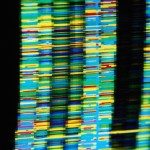Lien vers Pubmed [PMID] – 9611241
Nucleic Acids Res. 1998 Jun;26(12):2955-62
Human DNA topoisomerase I, known for its DNA-relaxing activity, is possibly one of the kinases phosphorylating members of the SR protein family of splicing factors, in vivo. Little is known about the mechanism of action of this novel kinase. Using the prototypical SR protein SF2/ASF (SRp30a) as model substrate, we demonstrate that serine residues phosphorylated by topo I/kinase exclusively located within the most extended arginine-serine repeats of the SF2/ASF RS domain. Unlike other kinases such as cdc2 and SRPK1, which also phosphorylated serines at the RS domain, topo I/kinase required several SR dipeptide repeats. These repeats possibly contribute to a versatile structure in the RS domain thereby facilitating phosphorylation. Furthermore, far-western, fluorescence spectroscopy and kinase assays using the SF2/ASF mutants, demonstrated that kinase activity and binding were tightly coupled. Since the deletion of N-terminal 174 amino acids of Topo I destroys SF2/ASF binding and kinase activity but not ATP binding, we conclude that at least two distinct domains of Topo I are necessary for kinase activity: one in the C-terminal region contributing to the ATP binding site and the other one in the N-terminal region that allows binding of SF2/ASF.

